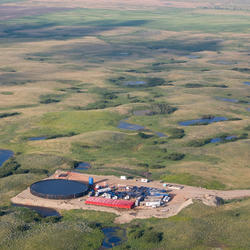Trace Levels of Organic Chemicals Limited to Local Reaches of a Stream near an Oil and Gas Wastewater Disposal Facility
A View of the New River from the New River Gorge Bridge
in West Virginia
Organic contaminants that were present in Wolf Creek near a wastewater disposal facility were not evident farther downstream where Wolf Creek enters the New River. Wolf Creek and the New River are used for drinking water and recreational purposes.

The disposal of large volumes of wastewater is an issue facing the unconventional oil and gas (UOG) production industry. Significant progress has been made in recycling water used in hydraulic fracturing and reducing the amount of wastewater generated. Most of the remaining wastewater is disposed of by deep underground injection because the wastewater is unsuitable for disposal in standard wastewater treatment plants. The risks due to leaks, spills, and migration of these fluids into natural waters are unknown.

Previous U.S. Geological Survey (USGS) studies determined the presence of inorganic contaminants related to UOG production in a small intermittent tributary to Wolf Creek that runs through a wastewater injection and disposal facility in West Virginia. In this current study, the organic chemical composition (nonpurgeable dissolved organic carbon, extractable hydrocarbons, C1–C6 hydrocarbons, biocides, and disinfection byproducts) and cell line toxicity were assessed in stream water and sediment samples collected upstream from, within, and downstream from the disposal facility, and at a background site in a separate drainage basin.
This current study supports the previous work done by the USGS and shows that organic substances consistent with a source from wastewater originating from UOG production were observed in stream water and sediments at sites immediately downstream from the facility. Concentrations of organics were low and included compounds like 2-(2-butoxyethoxy)-ethanol; tris(1-chloro-2-propyl)phosphate; α, α-dimethyl-benzenemethanol; 3-ethyl-4-methyl-1H-pyrrole-2,5-dione; and tetrahydro-thiophene-1,1-dioxide, which are all present in wastewater from UOG production. Toxicological assays of human cell line exposures to water and sediment from the creek showed minimal effects. Low-level organic contamination seems to be limited to the part of the creek immediately downstream from the facility. Organic contaminants were not evident farther downstream on Wolf Creek to the point where the tributary waters enter the New River, which are both used for drinking water and recreational purposes.
The USGS Environmental Health Program (Toxic Substances Hydrology and Contaminant Biology) of the USGS Ecosystems Mission Area and the USGS Energy Resources Program funded this study.

Below are other science teams and laboratories associated with this work.
Energy Resources Life Cycle Integrated Science Team
Examining Shifts in Stream Microbial Communities Exposed to Oil and Gas Wastewaters
Understanding Pathways of Unconventional Oil and Gas Produced Water Spills in the Environment
Indication of Unconventional Oil and Gas Wastewaters Found in Local Surface Waters
Fate and Effects of Wastes from Unconventional Oil and Gas Development
Microbiology and Chemistry of Waters Produced from Hydraulic Fracking—A Case Study
Below are publications associated with this Activities and Expertise.
Organic geochemistry and toxicology of a stream impacted by unconventional oil and gas wastewater disposal operations
Organic contaminants that were present in Wolf Creek near a wastewater disposal facility were not evident farther downstream where Wolf Creek enters the New River. Wolf Creek and the New River are used for drinking water and recreational purposes.

The disposal of large volumes of wastewater is an issue facing the unconventional oil and gas (UOG) production industry. Significant progress has been made in recycling water used in hydraulic fracturing and reducing the amount of wastewater generated. Most of the remaining wastewater is disposed of by deep underground injection because the wastewater is unsuitable for disposal in standard wastewater treatment plants. The risks due to leaks, spills, and migration of these fluids into natural waters are unknown.

Previous U.S. Geological Survey (USGS) studies determined the presence of inorganic contaminants related to UOG production in a small intermittent tributary to Wolf Creek that runs through a wastewater injection and disposal facility in West Virginia. In this current study, the organic chemical composition (nonpurgeable dissolved organic carbon, extractable hydrocarbons, C1–C6 hydrocarbons, biocides, and disinfection byproducts) and cell line toxicity were assessed in stream water and sediment samples collected upstream from, within, and downstream from the disposal facility, and at a background site in a separate drainage basin.
This current study supports the previous work done by the USGS and shows that organic substances consistent with a source from wastewater originating from UOG production were observed in stream water and sediments at sites immediately downstream from the facility. Concentrations of organics were low and included compounds like 2-(2-butoxyethoxy)-ethanol; tris(1-chloro-2-propyl)phosphate; α, α-dimethyl-benzenemethanol; 3-ethyl-4-methyl-1H-pyrrole-2,5-dione; and tetrahydro-thiophene-1,1-dioxide, which are all present in wastewater from UOG production. Toxicological assays of human cell line exposures to water and sediment from the creek showed minimal effects. Low-level organic contamination seems to be limited to the part of the creek immediately downstream from the facility. Organic contaminants were not evident farther downstream on Wolf Creek to the point where the tributary waters enter the New River, which are both used for drinking water and recreational purposes.
The USGS Environmental Health Program (Toxic Substances Hydrology and Contaminant Biology) of the USGS Ecosystems Mission Area and the USGS Energy Resources Program funded this study.

Below are other science teams and laboratories associated with this work.
Energy Resources Life Cycle Integrated Science Team
Examining Shifts in Stream Microbial Communities Exposed to Oil and Gas Wastewaters
Understanding Pathways of Unconventional Oil and Gas Produced Water Spills in the Environment
Indication of Unconventional Oil and Gas Wastewaters Found in Local Surface Waters
Fate and Effects of Wastes from Unconventional Oil and Gas Development
Microbiology and Chemistry of Waters Produced from Hydraulic Fracking—A Case Study
Below are publications associated with this Activities and Expertise.






